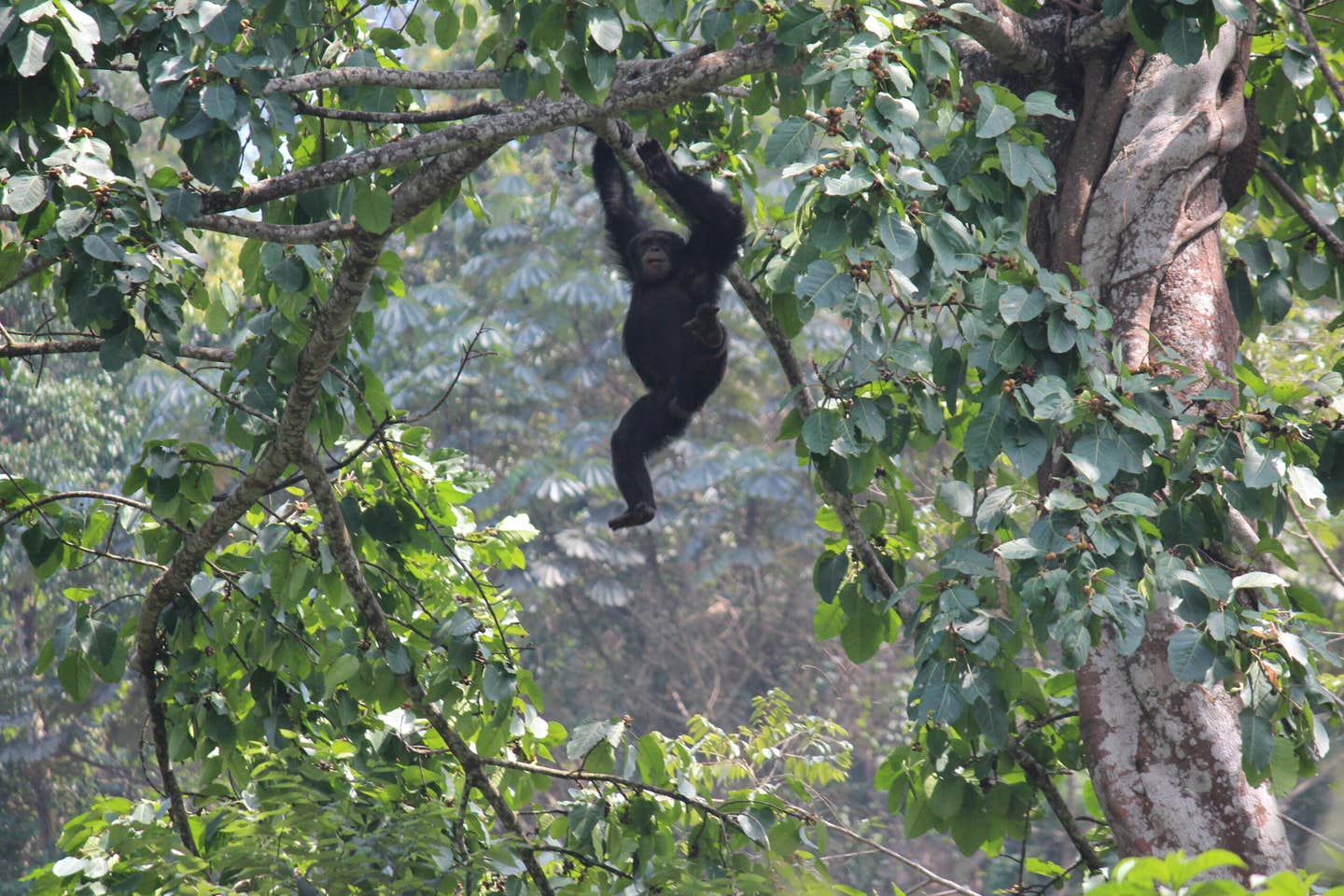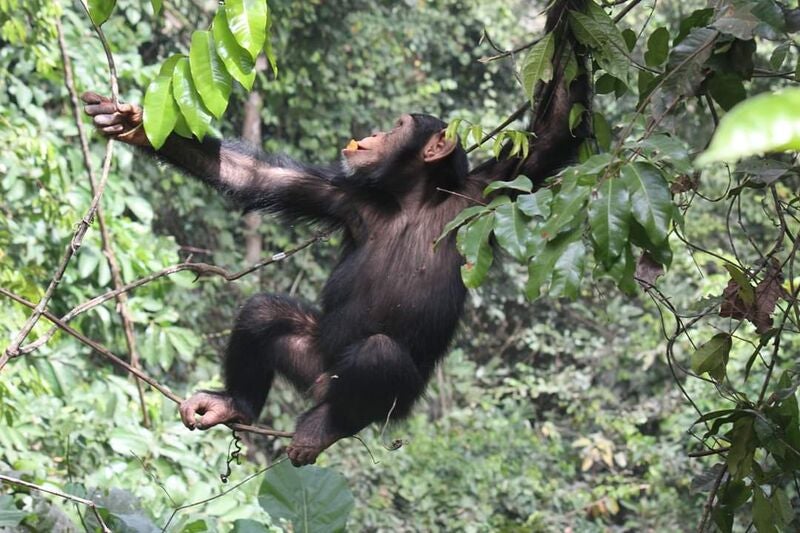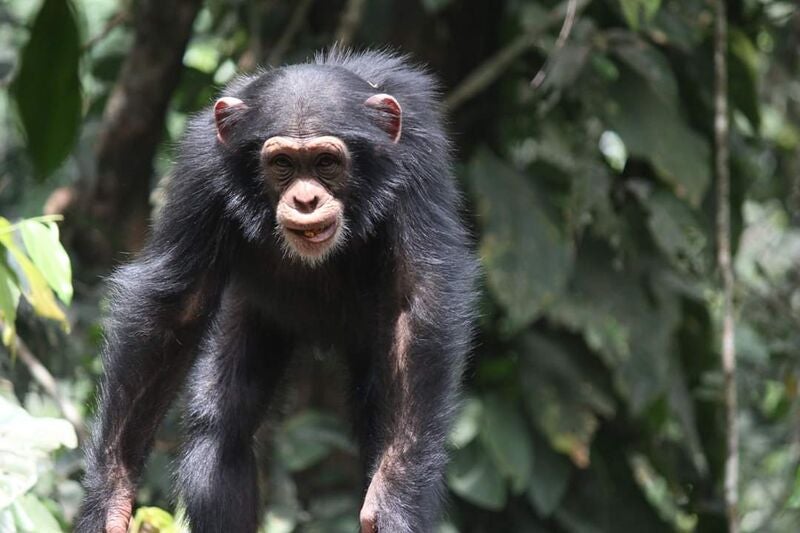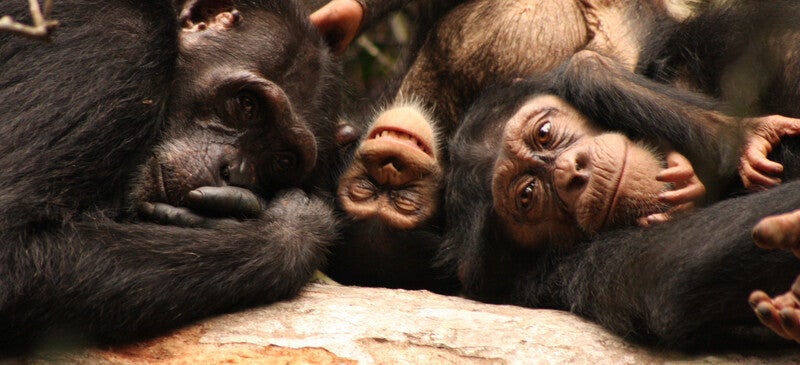For immediate release
Aug. 26, 2025
Download report, photos and videos
A group of seven international conservation and environmental organizations have asked the government of Guinea to implement a renewable five-year moratorium on iron-ore mining in the Nimba Biosphere Reserve, which includes a UNESCO World Heritage site. The Nimba Mountains straddle the border of Guinea, Côte d’Ivoire and Liberia, and are home to springs and streams that provide water to local communities in Guinea and habitat for critically endangered species, such as western chimpanzees. The massif is also a Key Biodiversity Area, which is a site of global importance to the planet’s overall health and the persistence of biodiversity on Earth.
“Guinea has only one World Heritage site, but many iron ore mining permits,” said Genevieve Campbell, head of the ARRC Task Force, which is part of the International Union for Conservation of Nature’s Primate Specialist Group, Section on Great Apes. “Mining companies have not demonstrated the effectiveness of the mitigation measures they are putting in place to reduce their impacts on biodiversity. Most damage from mining is essentially permanent; areas that have been mined are left looking like barren moonscapes for decades after operations have stopped. As mining intensifies due to our demand for minerals, we need to ensure that we won’t destroy the most ecologically important places on the planet to make smart phones and electric cars.”
In a letter dated July 2, the groups asked the minister of the environment and sustainable development and the minister of mines and geology to take specific steps to limit or prevent any negative impacts from future mining projects affecting the UNESCO World Heritage site. They recommended that the government:
- Conduct a regional strategic environmental and social assessment
- Take steps to better understand the risks of epidemics linked to mining activities
- Assess and secure alternative financing options for the Mt. Nimba World Heritage site
- Finalize and implement the Mount Nimba Biosphere Reserve management plan, including appropriate habitat protection and restoration measures for endemic and critically endangered species
The government of Guinea has not responded to the letter or a report outlining environmental concerns about mining on Mt. Nimba and alternatives to support its conservation.
A key-shaped section of Mt. Nimba was carved out of the world heritage site in 1993 for mining exploration, but scientists and conservationists argue that there needs to be an independent assessment to better understand the impacts of mining on Mt. Nimba’s water table, the wildlife that lives on the massif and the local communities that live around the massif.
“Nimba is home to exceptionally diverse and endemic flora and fauna, including threatened species, especially within the high-altitude grasslands,” said Angelique Todd, senior program manager, West and Central Africa for Fauna and Flora. “Among these species is the critically endangered western chimpanzee which has been found to be culturally unique at this site in their use of tools, nest-building and inclusion of crabs in their diet. Mining in this ecological haven not only has impacts on the areas under exploitation but across the wider landscape, affecting biodiversity and ultimately local peoples' access to ecosystem services - such as water and climate regulation - as well as their livelihoods and wellbeing.”
The mining concession cuts into several chimpanzee communities on the Guinean side of the Nimba Mountains. Mining activity—which includes building roads for heavy trucks, hauling materials and removing layers of mountain with industrial machinery to reach iron ore deposits—is extremely disruptive to chimpanzees and can cause them to restrict their movement and change their behavior.
“'Chimpanzees are threatened throughout their range, and in West Africa mining is an especially serious threat,” said Dirck Byler, great ape conservation director at Re:wild. “Around 70% of chimpanzees’ range in Guinea overlaps with mining permits. The Nimba Biosphere Reserve is an important chimpanzee habitat and protecting it is important not just for the individuals living in the reserve, but for ensuring the connectivity and conservation of the wider population.”
The Nimba mountains have been identified as one of seven priority sites for the broader conservation of western chimpanzees. A study published in 2023 was the first to count the number of chimpanzees living on Mt. Nimba and analyze their genetics. It estimated that more than 100 adult chimpanzees live on Mt. Nimba across four separate communities. An analysis of the DNA in more than 600 fecal samples showed that chimpanzees move between communities to mate and raise infants.
Mt. Nimba is one of the most biologically diverse places in West Africa, and home to unique species. The critically endangered Western Nimba toad lives in the high-elevation grassland areas of the mountains and gives birth to live young, instead of laying eggs like many other amphibians. Female toads nourish their babies during a nine-month gestation period and can give birth to up to 12 toads at a time.
“The Nimba Biosphere Reserve is one of the most irreplaceable strongholds for amphibian life on Earth,” said Gina Della Togna, executive director of Amphibian Survival Alliance. “The survival of the Mount Nimba Viviparous Toad and the Mount Nimba Reed Frog depends on urgent and unified conservation action. At ASA, we stand with our partners in calling for the protection of this vital refuge, because when these species vanish, there is no second chance.”
More than 500 species of animals have been described by Western science from the Nimba Mountains—some of those as recently as during the past five years. In 2021, scientists published a paper describing an orange-colored bat (Myotis nimbaensis) that was discovered in the mountains.
"Mount Nimba is recognized as a biodiversity hotspot for bats in Africa with at least 55 species known to live on the mountain and two species that are listed as critically endangered by the IUCN and found nowhere else on the planet,” said Winifred Frick, chief scientist for Bat Conservation International. “These species provide valuable ecosystem services to the ecological integrity of the mountain and surrounding landscape. The destruction of this irreplaceable habitat threatens to deliver a catastrophic blow to these bats and countless other species that depend on this ecosystem."
Extractive projects that disrupt highly biodiverse sites are especially concerning to scientists because they can increase the chances that humans could be exposed to new zoonotic diseases.
Mt. Nimba is an important source of water for communities in Guinea. It is known as the ‘water tower’ of West Africa and is the source of more than 50 springs and streams. Areas of Nimba that were destroyed by mining projects between the 1960s and 1980s in Liberia have not recovered and are still impacted by pollution.
Additional quotes
Stephan Doempke, chair of World Heritage Watch
"Mining on Mount Nimba is unacceptable. UNESCO and IUCN have a stated policy that it is incompatible with its World Heritage status, and the government of Guinea must abide by international law and stop the mining.”
# # #
Photo: A western chimpanzee in the Nimba Biosphere Reserve in Guinea. (Photo by Maegan Fitzgerald)
Re:wild
Re:wild protects and restores the wild. We have a singular and powerful focus: the wild as the most effective solution to the interconnected climate, biodiversity and human wellbeing crises. Founded by a group of renowned conservation scientists together with Leonardo DiCaprio, Re:wild is a force multiplier that brings together Indigenous peoples, local communities, influential leaders, nongovernmental organizations, governments, companies and the public to protect and rewild at the scale and speed we need. Learn more at rewild.org.
Bat Conservation International
Bat Conservation International is a global conservation organization dedicated to ending bat extinctions. Our team works worldwide to conserve caves, restore critical habitats in danger, and ensure the survival of the world’s bat species. For more information, visit batcon.org.
Fauna & Flora
Fauna & Flora is a nature conservation charity protecting the diversity of life on Earth. For the survival of species and habitats, the planet and people.
As the world’s first international conservation charity, Fauna & Flora has been shaping best practice in community-focused conservation for over 120 years. Today, the charity works closely with local conservation partners in almost 50 countries to protect habitats, revive the ocean, reduce extinctions, stop illegal wildlife trade, combat climate change and influence global policy and corporate sustainability. www.fauna-flora.org
Amphibian Survival Alliance
The Amphibian Survival Alliance (ASA) promotes the conservation of amphibians and their habitats through dynamic partnerships worldwide. ASA raises awareness of amphibians and their plight, and helps channel resources towards the implementation of vital conservation actions, as guided by the global Amphibian Conservation Action Plan. ASA works directly with the IUCN SSC Amphibian Specialist Group and Amphibian Ark to achieve the shared vision of “Amphibians thriving in nature”. ASA champions the extraordinary work of its partners to build a strong, collaborative future for amphibian conservation. Learn more at www.amphibians.org.
World Heritage Watch
World Heritage Watch is a global network of civil society actors who monitor UNESCO World Heritage Sites. The organization alerts UNESCO, the general public and the wider heritage community about unwanted developments at the sites and works towards a stronger role of civil society in the implementation of the World Heritage Convention.
IUCN Species Survival Commission Primate Specialist Group ARRC Task Force
The International Union for the Conservation of Nature (IUCN) is “the global authority on the status of the natural world and the measures needed to safeguard it.”The IUCN has six commissions. The Commission concerned with the protection of species is the Species Survival Commission (SSC), which comprises more than 160 Specialist Groups that focus on different species and conservation issues, one of them being the Primate Specialist Group (PSG). The PSG has a Section on Great Apes (SGA) dedicated to orangutans, chimpanzees, gorillas, and bonobos. Making up this section are more than 150 of the world’s leading experts in great ape conservation. The SGA officially launched its ARRC (Avoid, Reduce, Restore, and Conserve) Task Force in 2020 to deal specifically with the major threats to apes steaming from large scale development projects. Learn more at https://arrctaskforce.org/
Contact
Devin Murphy
+1 512-686-6188
dmurphy@rewild.org
Kathryn Slater
+1 512-327-9721 Ext. 463
kslater@batcon.org

Devin Murphy
Writer
Devin Murphy is Re:wilds’s senior communications specialist and helps Re:wild and its partners tell stories about the work they do to protect wildlife and wildlands around the planet. Her favorite stories about conservation include fascinating and little-known species and the dedicated humans protecting them.



